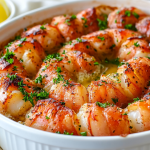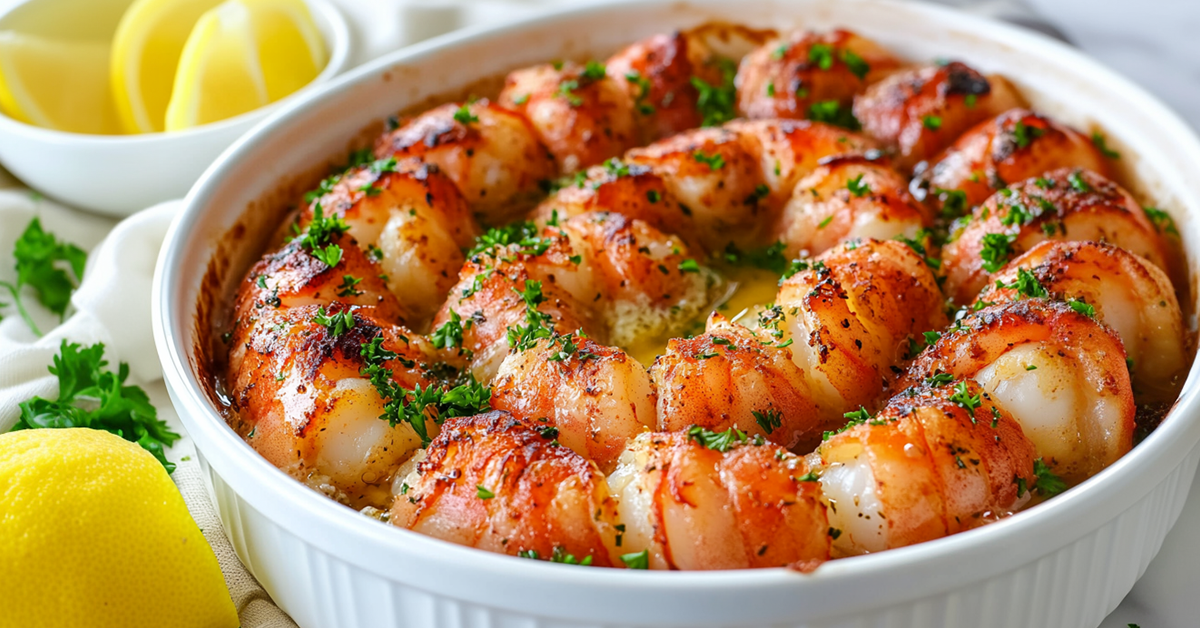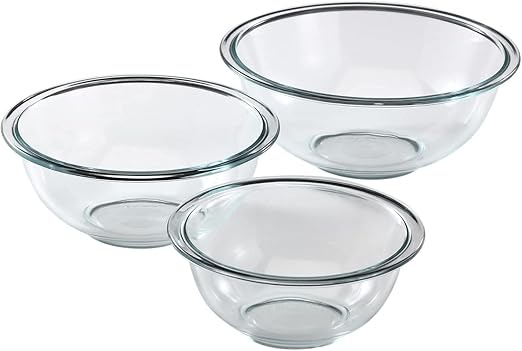Disclosure: As an Amazon Associate and participant in other affiliate programs, we earn from qualifying purchases. We only recommend products we believe will provide value to our readers.
Whether you’re rushing to prepare dinner or planning a quick weekend meal, a reliable baked shrimp recipe can be your perfect solution.
You might think cooking frozen shrimp requires lengthy preparation, but this simple method transforms frozen shrimp into a delicious meal in just 20 minutes.
This oven baked shrimp recipe eliminates the usual hassles of thawing and extensive prep work.
In fact, baking shrimp directly from frozen helps preserve their natural sweetness and tender texture. Best of all, you’ll learn how to achieve restaurant-quality results using basic ingredients and your home oven.
You’ll discover the exact temperature settings, timing, and techniques for perfectly baked shrimp every time.
This guide also includes helpful tips for selecting shrimp, seasoning suggestions, and serving ideas to create a complete meal your family will love.
Table of Contents
Essential Tips for Perfect Oven-Baked Shrimp
Getting perfect oven-baked shrimp starts with understanding a few essential techniques. First, pat your shrimp dry thoroughly before seasoning – this ensures they’ll bake evenly instead of steaming in excess moisture.
Specifically, when preparing your baking sheet, line it with parchment paper or aluminum foil for easy cleanup. Furthermore, arrange the shrimp in a single layer with space between each piece to promote even cooking and proper browning.
Here are the key tips for perfect oven-baked shrimp every time:
- Choose shrimp that are uniform in size to ensure even cooking
- Season generously with olive oil to prevent sticking
- Arrange shrimp in a single layer, avoiding overcrowding
- Check for doneness at the thickest part of the shrimp
- Remove from oven as soon as shrimp turn pink and opaque
Importantly, avoid the common mistake of overcooking your shrimp. They continue cooking for a minute or two after removing them from the oven due to residual heat. Take them out when they’re just turning pink and opaque, rather than waiting until they’re completely firm.
When it comes to seasoning your baked shrimp recipe, keep it simple at first. A combination of olive oil, salt, and pepper allows the natural sweetness of the shrimp to shine through. Additionally, you can experiment with garlic, lemon, or herbs once you’ve mastered the basic technique.
For frozen shrimp, arrange them on your baking sheet while still frozen – no need to thaw. Simply add an extra 2-3 minutes to your cooking time. This method actually helps preserve the shrimp’s natural texture and prevents them from becoming rubbery.
Remember to position your oven rack in the middle position for even heat distribution. This placement ensures your shrimp cook uniformly without burning on top or bottom. Moreover, preheating your oven completely before adding the shrimp is crucial for achieving the perfect texture.
Watch for visual cues during baking – properly cooked shrimp form a “C” shape, while overcooked shrimp curl into a tight “O” shape. This simple observation can help you achieve perfectly cooked shrimp every time.
Read also: Fried Fish and Shrimp Recipe
The Best Temperature for Baking Shrimp in Oven
Setting the right temperature is crucial for your baked shrimp recipe. Understanding how different temperatures affect your shrimp will help you achieve perfect results every time.
Different temperature settings and their effects
The ideal temperature range for baking shrimp falls between 350°F and 425°F. Your choice within this range affects both cooking time and final texture. Here’s what happens at different temperatures:
- 350°F – Gentle cooking, preserves moisture
- 375°F – Balanced cooking with light browning
- 400°F – Quick cooking with more browning
- 425°F – Fast cooking with crispy exterior
How cooking time varies with temperature
Consequently, your cooking time needs adjustment based on your chosen temperature. At 400°F, medium-sized shrimp typically cook in 8-10 minutes. Nevertheless, if you’re baking at 350°F, plan for 12-15 minutes of cooking time.
Impact of oven temperature on shrimp texture
Temperature significantly influences your final result. Accordingly, lower temperatures (350-375°F) produce tender, juicy shrimp with minimal shrinkage. Higher temperatures (400-425°F) create a firmer texture with more pronounced exterior browning.
Temperature guidelines for different shrimp sizes
Your shrimp size determines the ideal temperature and timing combination. Here’s a helpful guide:
| Shrimp Size | Temperature | Cooking Time |
|---|---|---|
| Small (51-60 per pound) | 400°F | 6-8 minutes |
| Medium (31-35 per pound) | 375°F | 8-10 minutes |
| Large (21-25 per pound) | 375°F | 10-12 minutes |
| Jumbo (16-20 per pound) | 350°F | 12-15 minutes |
For frozen shrimp, maintain the same temperature settings and add 2-3 minutes to these cooking times. Keep in mind that overcooking leads to tough, rubbery texture, therefore watching your timing is essential.
A consistent oven temperature throughout cooking ensures even results. Consider using an oven thermometer for accuracy, since many ovens can run slightly hot or cold. Furthermore, allowing your oven to fully preheat helps maintain steady temperature and prevents uneven cooking.
For the most reliable results with your oven baked shrimp, start with a temperature of 375°F. This middle-ground setting offers enough heat to cook thoroughly without risking overcooking, especially if you’re new to baking shrimp.
Read also:
– Smoked Shrimp Recipe
– Butter Poached Shrimp Recipe

Easy Baked Shrimp Recipe
- Total Time: 19 minutes
- Yield: 4 portions 1x
Description
Initially, this delightful baked shrimp recipe transforms simple ingredients into a flavorful meal that’s perfect for busy weeknights or elegant entertaining. Your family will love how the shrimp emerge from the oven tender and succulent, bathed in a savory garlic butter sauce.
This versatile oven baked shrimp recipe delivers perfectly cooked shrimp in just 20 minutes. The shrimp are seasoned with a blend of garlic and herbs, afterward baked until they’re pink and tender, creating a dish that’s both elegant and effortless.
Ingredients
- 1 pound large shrimp, peeled and deveined
- 2 tablespoons olive oil
- 3–4 cloves garlic, minced
- 1 tablespoon lemon juice
- 1 teaspoon smoked paprika
- ¾ teaspoon salt
- ¼ teaspoon black pepper
- Optional: red pepper flakes for heat
- Fresh parsley for garnish
Instructions
- Preheat your oven to 400°F.
- Line a baking sheet with parchment paper for easier cleanup.
- Pat the shrimp dry thoroughly with paper towels.
- Place shrimp in a large bowl, coupled with olive oil and seasonings.
- Toss until shrimp are evenly coated with the seasoning mixture.
- Arrange shrimp in a single layer on the prepared baking sheet.
- Bake for 7-9 minutes, or until shrimp turn pink and opaque.
- Remove from oven and finish with a squeeze of fresh lemon juice.
Notes
- Above all, avoid overcrowding the baking sheet to ensure even cooking.
- For frozen shrimp, thaw completely under cold running water and pat dry before seasoning.
- Similarly to fresh shrimp, frozen ones should be arranged in a single layer.
- The shrimp will keep in your refrigerator for 3-4 days.
- Prep Time: 10 minutes
- Cook Time: 9 minutes
- Category: Seafood
- Method: Baking
- Cuisine: American
Serving Suggestions for Your Baked Shrimp
Transform your baked shrimp recipe into a complete meal with these versatile serving suggestions. From casual weeknight dinners to elegant entertaining, your oven baked shrimp can be the star of countless delicious combinations.
For a classic pairing, serve your shrimp over a bed of perfectly cooked rice or pasta. Notwithstanding these traditional options, quinoa or cauliflower rice offer lighter alternatives that soak up the flavorful sauce just as well.
Although your shrimp bake stands beautifully on its own, these side dishes elevate it to a complete meal:
- Roasted asparagus or green beans
- Garlic-sautéed spinach
- Mediterranean couscous
- Crusty French bread
- Grilled zucchini
- Citrus-dressed arugula salad
- Roasted fingerling potatoes
Meanwhile, presentation can transform your oven baked shrimp from everyday fare to an impressive dish. Generally, arrange the shrimp in a circular pattern on a white serving platter, indeed creating an eye-catching display.
Garnish with fresh herbs, lemon wedges, or cherry tomatoes for a pop of color.
| Occasion | Serving Style | Accompaniments |
|---|---|---|
| Casual Dinner | Family Style | Crusty bread, simple salad |
| Date Night | Individual Plates | Wine-paired sides, candlelight |
| Party Appetizer | Small Plates | Cocktail sauce, lemon wedges |
| Lunch | Bowl Style | Mixed greens, grains |
Your baked shrimp in oven can alternatively become part of these meal ideas:
- Shrimp Pasta Bowl: Toss with angel hair pasta, olive oil, and fresh herbs
- Protein-Rich Salad: Place atop mixed greens with avocado
- Seafood Tacos: Wrap in warm tortillas with slaw
- Rice Bowl: Serve over jasmine rice with roasted vegetables
For entertaining, position your shrimp bake as part of a seafood spread. Ultimately, the versatility of this dish allows you to adapt it for any dining occasion, from quick family meals to sophisticated dinner parties.
Consider temperature when planning your sides – warm sides complement hot shrimp, whereas cool, crisp salads offer pleasant contrast. Remember to have serving utensils that make it easy for guests to portion the shrimp without disturbing the beautiful arrangement.
For a refreshing twist, try serving your oven shrimp chilled over a crisp summer salad. This preparation method works particularly well for outdoor gatherings or warm-weather entertaining. Pair with a crisp white wine or light rosé to complete the experience.
Read also: Shrimp Head Recipe
Health Benefits of Baked Shrimp
Choosing a baked shrimp recipe for your meals brings numerous health advantages to your diet. Unlike fried alternatives, oven baked shrimp preserves essential nutrients without adding unnecessary calories.
Your body benefits from shrimp’s impressive protein profile, as it provides all nine essential amino acids needed for muscle maintenance and growth.
Remarkably, a 3-ounce serving of baked shrimp contains about 20 grams of high-quality protein, making it an excellent choice for fitness enthusiasts and those watching their weight.
The advantages of preparing shrimp in oven extend beyond just protein content. Here are key nutritional benefits you’ll receive:
- Essential omega-3 fatty acids for heart health
- Selenium for immune system support
- Vitamin B12 for nerve function
- Iodine for thyroid health
- Zinc for wound healing
- Astaxanthin for anti-inflammatory properties
Preparing your shrimp bake helps preserve these nutrients better than other cooking methods. Through baking, you maintain the delicate balance of nutrients without introducing excess oils or fats that might compromise your health goals.
| Nutrient | Benefit to Your Body |
|---|---|
| Protein | Supports muscle growth and repair |
| Omega-3s | Promotes heart and brain health |
| Selenium | Boosts antioxidant protection |
| Vitamin D | Enhances calcium absorption |
| Iron | Supports oxygen transportation |
Opting for an oven shrimp preparation method supports your cardiovascular health. Undoubtedly, this cooking technique requires minimal added fats, hence helping you maintain healthy cholesterol levels.
Additionally, the natural compounds in shrimp support blood vessel flexibility and proper circulation.
Your immune system gets a boost from regularly including baked shrimp in oven in your meal rotation. Forthwith, the zinc and selenium content works together to strengthen your body’s natural defenses. Simultaneously, these nutrients help protect your cells from damage.
Weight management becomes easier with baked shrimp recipes. Considering that a standard serving contains roughly 84 calories, you can enjoy a satisfying meal without derailing your dietary goals.
Straightaway, the high protein content helps you feel full longer, reducing the likelihood of unhealthy snacking between meals.
Brain health improvements come from consuming oven baked shrimp regularly. Inasmuch as shrimp contains essential fatty acids and vitamin B12, it supports cognitive function and may help maintain mental clarity as you age.
Together with its anti-inflammatory properties, these nutrients create a powerful combination for overall brain health.
The cooking method of your shrimp bake plays a crucial role in maximizing these health benefits. By choosing to bake rather than fry, you:
- Preserve more nutrients
- Avoid unnecessary oil absorption
- Maintain the natural flavor profile
- Keep the calorie content lower
Incorporating baked shrimp into your weekly meal plan provides long-term health advantages. Overall, this lean protein source offers impressive nutritional density while remaining versatile enough to prevent meal fatigue.
Plus, the quick cooking time of this bake shrimp in oven method helps you maintain healthy eating habits even with a busy schedule.
References:
– Healthline
– WebMD
Nutritional Information of Baked Shrimp
Understanding the nutritional profile of your oven baked shrimp helps you make informed dietary choices. Let’s explore the specific nutritional components that make this dish a smart addition to your meal plan.
A standard 3-ounce serving (about 8-10 medium shrimp) of baked shrimp recipe provides these key nutrients:
| Nutrient | Amount per Serving |
|---|---|
| Calories | 84 |
| Protein | 20g |
| Total Fat | 1.7g |
| Cholesterol | 165mg |
| Sodium | 805mg |
| Carbohydrates | 0g |
| Iron | 2.6mg |
| Potassium | 220mg |
Primarily, your shrimp bake preparation method affects its nutritional value. Subsequently, baking preserves nutrients better than frying, markedly reducing added fats and calories.
When preparing your baked shrimp in oven, the cooking process requires minimal oil, keeping the fat content naturally low.
The macronutrient distribution in your oven shrimp makes it an excellent choice for various dietary preferences:
- Protein: Makes up approximately 85% of total calories
- Fat: Contributes roughly 15% of total calories
- Carbohydrates: Virtually zero, making it suitable for low-carb diets
Comparatively, different serving sizes affect your nutritional intake:
| Portion Size | Calories | Protein | Fat |
|---|---|---|---|
| Small (2 oz) | 56 | 13g | 1.1g |
| Medium (3 oz) | 84 | 20g | 1.7g |
| Large (4 oz) | 112 | 26g | 2.3g |
Your baked shrimp serving size depends on several factors:
- Your daily caloric needs
- Protein requirements
- Dietary restrictions
- Meal composition
Presently, the recommended serving size for your shrimp in oven varies based on age and activity level. Alternatively, you might adjust portions depending on whether you’re serving it as a main dish or appetizer.
The mineral content of your oven baked shrimp provides essential nutrients:
| Mineral | Percentage of Daily Value |
|---|---|
| Selenium | 48% |
| Zinc | 9% |
| Copper | 10% |
| Magnesium | 7% |
Your bake shrimp in oven preparation affects sodium content. Ultimately, controlling added salt during cooking helps manage sodium intake while maintaining flavor. Consider these sodium-conscious preparation tips:
- Use herbs and spices instead of salt
- Opt for fresh rather than pre-seasoned shrimp
- Rinse frozen shrimp before cooking
- Season lightly during cooking
The vitamin profile of your baked shrimp recipe includes:
| Vitamin | Amount per Serving |
|---|---|
| B12 | 1.8mcg |
| D | 120IU |
| E | 2.2mg |
| B6 | 0.1mg |
References:
– Eat This Much
Conclusion
Baked shrimp stands out as a perfect solution for nutritious, quick meals without compromising on taste or quality.
This simple cooking method transforms frozen shrimp into a delicious dish while preserving their natural sweetness and essential nutrients.
Armed with the right temperature settings and timing guidelines, you’ll achieve perfectly cooked shrimp every time. Whether served over rice, tossed with pasta, or added to fresh salads, your baked shrimp will become a versatile staple in your weekly meal rotation.
Remember that successful shrimp baking relies on three key factors: proper temperature control, careful timing, and mindful arrangement on your baking sheet. Following these guidelines helps you create tender, flavorful shrimp while maintaining their impressive nutritional benefits.
Start with this basic recipe, then experiment with different seasonings and serving combinations once you’ve mastered the technique.
Your family will appreciate this quick, healthy option that delivers restaurant-quality results right from your home oven.













